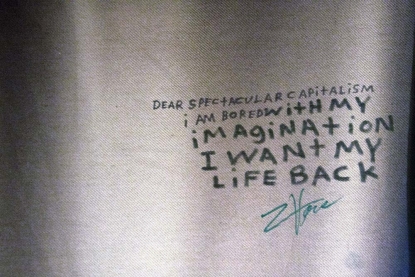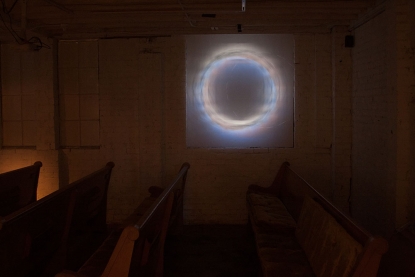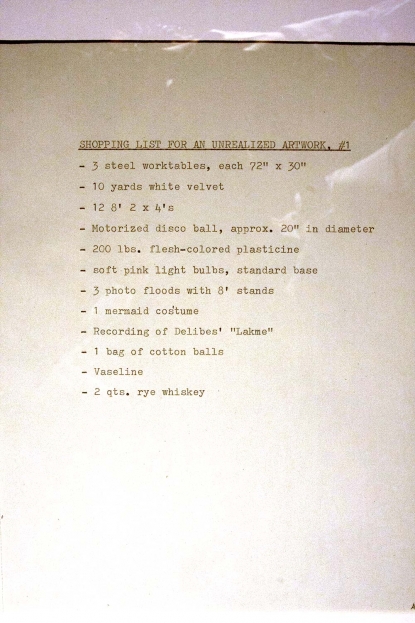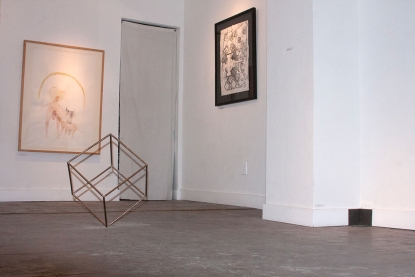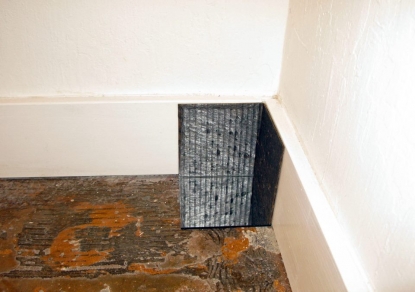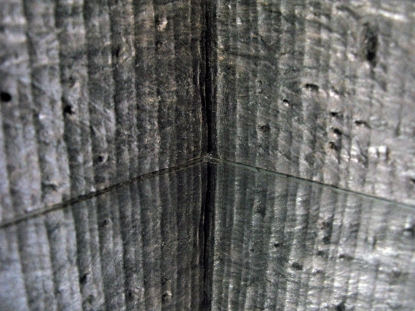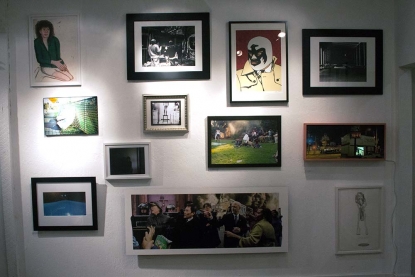
Wall in Main Room with work by: Terri Bowen, Sasha Kelley, Cherie Chavez, Ryan Chard Smith, Adenike Amin, Jesus Barraza, Martha Chong, Tracey Snelling, Aurie Ramirez
Feature: Reviews
DocumentO at Krowswork
- Krowswork
- Oakland, CA
- June 22 – July 1, 2012
It’s dismaying that in an ever increasingly post-global world, defensive provincialism still reigns in the bay area when it comes to regional group shows. The notion of New York City being the center fount of the arts holds less and less water every day. As Jennifer Allen wrote in Frieze:
“The projection of the New York art world as the metropolitan center for art by every other art world is symptomatic of the provincialism of each of them.”
Generally, local survey shows serve as a sort of generic cheerleading of work that is either novel or salable or both. At worst, they can be confused messes, lacking a sense of representation or story of a place or scene. At best, such shows provide a sense of both place and story – but more than that, they propose a larger thematic vision than the individual art itself.
Given the massive amount of work put into Yerba Buena Center for the Arts' Sampling Oakland and Oakland: East Side Story, it was unfortunate that both shows seemed to pose simplistic political arguments between two groups of young artists – the “gentrifying white hipster” versus the “artist/activist of color” – neither wholly representative of the Oakland I see. Other than that, the work mostly appeared to be whatever was hip and buzzed about in the galleries in that particular season. In fact, many of the artists showcased in those shows went to gallery representation soon after.
There is of course, much irony to be had in pointing out that many of the activist artists who are critical of capitalism (or are just plain against it) are some of the biggest boosters of Oakland as a cultural (read: tourist) destination. There is a good reason why Oakland was recently named by the New York Times as the number five city to visit in the world this year. As Gordon Winiemko noted in a previous Stretcher piece, Sampling What? speaking about the Black Dot Collective’s “wall-length, man-height row of letters spelling out OAKLAND, like a Norcal Hollywood sign (A Shrine To The Anti-Gentrification Gods of Oakland, May They Protect Us From The Invaders)”
“…when you consider that Oakland is a place with a large population of African Americans, and that the mission of the Collective is precisely to raise visibility of this historically disenfranchised group, then boosterism starts to look more like activism, such that any complexity that might be lacking seems beyond reproach.”
Winiemko puts the central problem of most of these shows clearly here:
“With a regional survey, there’s the added difficulty in that what is being represented is not some concept or category, but a place, with all the history and associations that implies.”
Unfortunately in the YBCA's pair of Oakland survey shows the feeling I was left with was much more didactic than dialectic.
Krowswork's recent DocumentO was organized under the guise of being an unofficial satellite of the Documenta (13) exhibition. This was made clear through the requisite written and graphical materials displayed about as well as the placement of the works which suggested an underlying comment on Oakland's recent troubles, embarrassments and triumphs.
Oakland is city where a reporter caught our mayor red handed, cherry picking facts which were in fact lies to a federal grand jury while in the process of literally cherry picking at a Farmer's market. It sits on the edge of a likely federal takeover of its often brutal and ineffectual police force. It’s also a rising cultural force, much heralded in the local and national press. It is of course, a city of contradictions and cannot be easily pegged. That is why perhaps so many of the previous efforts to do a survey of its art community have fallen short. This show however, for me, has come closest to making a progressive, representative statement of the many subcultures that make up the community of artists currently practicing in Oakland today.
Planning for the show started in early May and included studio visits and the commissioning of site specific work like Chris Fraser's Eclipse, a camera obscura depicting the sun's corona projected on the inside wall of the gallery's main screening room. Almost all the work in the show was new or made in the last year.
There was a little of everything, from conceptual lists and multiple works inspired by Sol Le Witt, to painterly minimalism and experimental video; and of course, a smattering of work steeped to varying degrees in illustration – a Bay Area hallmark hailing back to the days of the Mission School. To call the show staggering is as much an understatement and a compliment as a detriment.
In a show swollen with highlights, here are some standouts: Anthony Discenza's SHOPPING LIST FOR AN UNREALIZED ARTWORK, #1 is a great example of the humor infused conceptualism that has such a local rich history from folks like Tom Marioni and Lowell Darling (the latter incidentally had solo show at Krowswork in March). The piece is a framed, typed list that reads:
- 3 steel worktables, each 72” X 30”
- 10 yards white velvet
- Motorized disco ball, approx. 20” in diameter
- 200 lbs. Flesh colored plasticine
- 3 photo floods with 8' stands
- 1 mermaid costume
- Recording of Delibes' “Lakme”
- 1 bag of cotton balls
- Vaseline
- 2 qts. Rye whiskey
Near it hangs Eesuu Orindide's We Define Wealth, a mixed-media work that depicts the message of its title in paint and debris. As Jasmine Moorhead, DocumentO’s curator tells me, “[Eesuu's] work is an reevaluation of capitalism as we know it.” Contrasting it with that of Discenza and Packard Jennings (whose often design heavy and humor infused work seemingly serves as a gateway drug into alternative political thought) – a salient regional dialectic begins to emerge. Moorhead elaborated as much saying, “There has been a lot of press from the NYT and the WSJ about the “Oakland scene” but very little critical attention to the actual art coming out. What now needs to happen is more serious critical dialogue about the art itself.”
In a show of over 50 artists spread over four small rooms, something eventually gets lost in translation. If the work is successful – it succeeds as much on its own merits as being placed alongside other compelling works. As Aaron Harbour noted in his review for ARTCARDS,
“...some pieces still managed to carve out space enough to be read, but, in general, little beyond immediate visceral aesthetic affect was offered.”
Having noted these concerns, perhaps the most effective display of work was in the room that was the messiest – the large, middle room with work displayed on the floor and all four walls – one of them salon style. On one wall, Harvey, San Pablo Avenue, Oakland, a museum-ready Tracey Snelling mixed-media piece depicting an Oakland neighborhood landscape with video edited to highlight the irony and accidental encounters one might find in such a place. On a another wall, multiple Jesus and Batmans hold court in Veronica De Jesus's effectively cheeky Jesus and Batman Channel, a fine example of the prominence drawing holds in the Bay Area.
The most effective work in the room could be easily missed. I am speaking of the work on the floor that seemingly refers to past works by Sol LeWitt. Nearly central, planted on its side like a child's top caught in half-spin lies Randy Colosky humorously titled A Cubic Foot of Support. The piece is a outlined cube made of nickel-plated rebar, 12x12x12 inches on each side. The work can rotate on its its corner, changing its arrangement by its individual orbit. It exists both singularly and as a multiple, affecting many possible spaces within its diameter.
Just across from it, placed in the gallery corner sits a work that exists in multiple immediacy, elegantly and grandly stating purpose and function. Daniel Healey's Drawing out the corner is made of carved, drawn cardboard, sculpted into a corner with two walls of board and a mirror parsing out into infinity. It too evokes LeWitt in grand fashion, suggesting possibility where one would see trash or detritus. It feels like Oakland, because the art community here is scrappy, held together by bailing wire to invoke a cliché – it is true, riots and celebrations are the everyday here.
The problem with past Oakland survey shows was the evident self-segregation implied by the placement of the work on display. Such arrangement mostly inhibits rather than sparks dialogue, to be sure. DocumentO is in some ways messy, but it mostly works and its complicated nature befits the city of its birth. Some of it is didactic, but mostly it works towards a progressive dialectic. If Moorhead had more budget and more time, surely the show would be more polished. If there are to be more shows like this in the future, I hope they manage to strike a feeling much like this one. The arrangement of these 50 works suggests a conversational tone that says something a bit more subtle, nuanced and clear than “us and them”.

